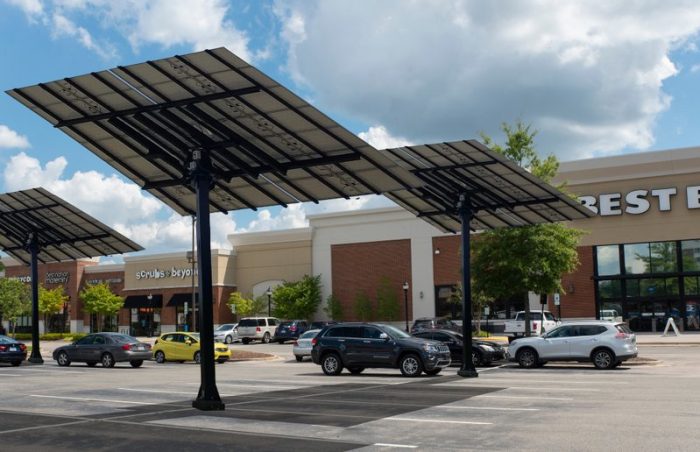
This piece was submitted by Stracker Solar.
With parking lots taking up roughly one-third of the land area across cities in the U.S., and rising concerns about the loss of arable land to industrial-size solar farms, attention has turned to how parking lots can be a vital option for energy generation. Beyond the readily available wide-open space with great sun exposure that parking lots present, they’re also ideal locations for large-scale solar generation, offering EPCs and developers great business potential.
Clean power and profit with solar parking lots
When installing solar, three main considerations are the amount of energy that can be generated, site constraints, and the proximity of the solar power system to where the electricity will be used.
Roof-mounted solar offers ease of proximity, but EPCs often face limitations regarding roof penetration and ballasted load requirements or the size or condition of the roof, which all affect the amount of energy that can be produced.
Meanwhile, ground-mounted solar can be placed more easily given that generally all one needs is open land with good sun exposure and enough space. But in cities where real estate is already at a premium, this is not a viable route for large-scale energy production.
So, the result is ground-mounted solar farms installed far outside of city limits, with increased transmission costs and significant energy losses. And since these big solar farms take up a lot of land that could otherwise be used for agriculture, recreation, or simply to maintain open green space, there’s more and more public pushback against them. Last year, at least 75 large solar farm projects were vetoed across the U.S., compared to 19 in 2021.
This challenge is a great opportunity for those developers and EPCs who turn their attention toward urban areas and innovative technologies that were developed specifically for distributed generation.
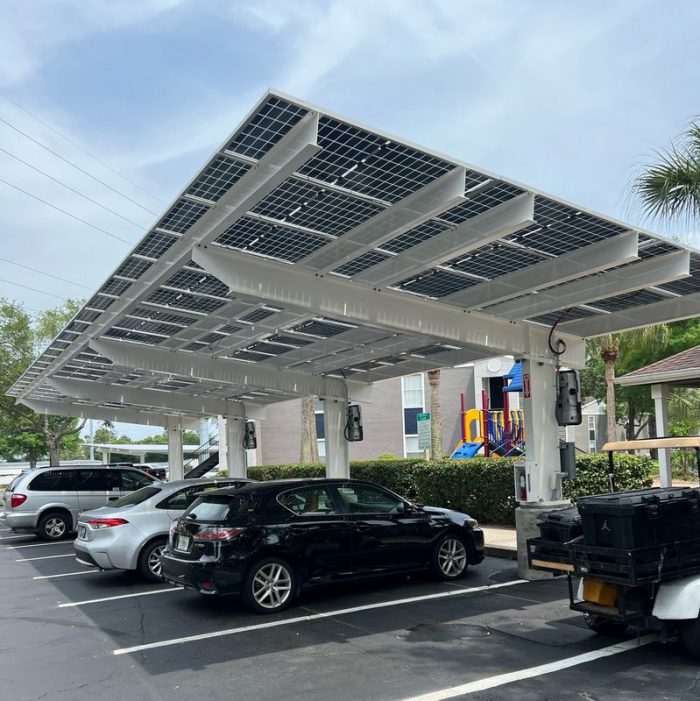
Enter parking lots. These spaces are already near buildings and communities that will use the electricity produced, reducing or eliminating any concerns associated with transmission costs and energy losses. They are also developed sites and typically not the most beautiful, so adding solar power generation to them can just enhance their aesthetics and increase their value.
After factoring in the benefits of shade and extra features like lot lighting and EV charging stations, EPCs and developers can expect public support for parking lot solar projects. With the right technologies, these installations can easily be designed to meet the needs of clients and communities and can serve as revenue sources for property owners and power-generating hubs for entire neighborhoods through community solar programs.
Solar carports or elevated dual-axis solar trackers?
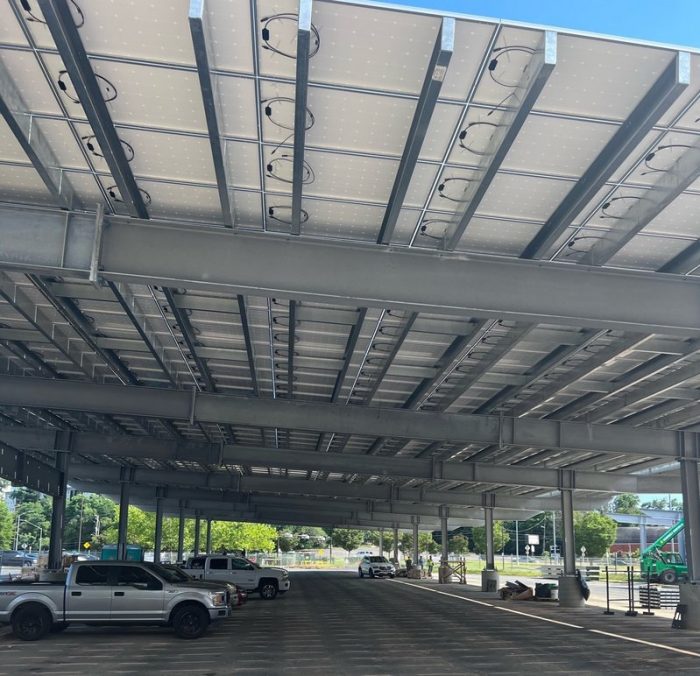
To help EPCs and developers decide which mounting structure to consider for their next parking lot solar project, let’s take a look at the benefits and features of the two available solutions.
Space utilization and energy production | Solar carports are certainly a most cost-efficient option for parking lots that already have carports installed, as it can be as simple as just adding solar panels onto the roof of the structures. For open parking lots, space and energy production analyses will help decide between the two solutions.
Depending on the design, installing carport structures can take up several parking spots, while the minimal mounting base of pole-elevated solar trackers allows installation without losing parking spaces. The pedestal of Stracker Solar’s elevated solar trackers, for example, takes up less than 5 square feet and fits easily between parking spaces.
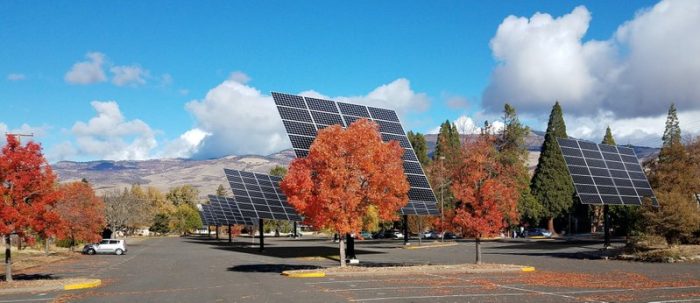
To meet the energy needs of a project, fixed carports will use roughly 50% more PV panels than dual-axis solar trackers. Sites need to have enough space for the size, and also for the ideal orientation, of a fixed carport system to capture enough energy. If we add to that site restrictions and building department requirements, it’s easy to see why EPCs often find it challenging to design their parking lot projects with fixed carports and generate enough power.
This is where elevated dual-axis solar trackers can make a difference. These single-pole-mounted solar structures offer great design flexibility, site compatibility, and maximum energy production. As an elevated solar tracker moves with the sun all through the day, it generates 50-70% more energy than fixed solar carport systems of the same size.
Power production comparison
Let’s compare a 200 kW Stracker dual-axis solar tracker installation and a typical 200 kW carport system in a 40 deg latitude, with the same number and type of panels and inverters.
The 200 kW Stracker install, consisting of 16 Model S1B Strackers, will produce 480 MWh electricity per year. The carport system, assuming a 5-degree, south-facing tilt, will produce 280 MWh power per year. This illustrates the above-mentioned 70% greater energy production of elevated dual-axis solar trackers.
On top of this energy gain, the Strackers also have a 65% lower greenhouse gas footprint per kWh produced, due to the increased power coming from each PV module (the PV modules account for more than 90% of a typical PV system’s embedded carbon).
Upkeep and maintenance
Because solar carports are fixed structures, dirt, snow and detritus from the use of the parking lot can accumulate on the panels and impact energy production. Solar carports require cleaning at least a few times a year and depending on the winter weather in a project’s area, may need regular snow removal to clear panels.
With an elevated dual-axis solar tracker, panel cleaning is not needed. The arrays are lifted 14 to 35 feet above the ground, which keeps the panels above the typical dust patterns and canopy of trees, and the constant movement makes them shed snow and detritus, such as leaves.
The physical structure of steel carports, just like that of steel pole-mounted solar trackers, should require minimal upkeep – annual visual inspection and occasional paint touch-up is all that is needed. On top of this, the only maintenance that elevated dual-axis solar trackers need is the annual zerk lubrication of the drive-core.
Aesthetics
Here the age-old adage of beauty being in the eye of the beholder definitely applies. Without discussing the many different designs carport manufacturers offer, in general, there is one major difference in aesthetics between solar carports and elevated solar trackers: carports take up more open visual space, creating a sort of enclosed and protected feeling, which may be preferable for some clients, but not for others.
Auto dealerships and some retail stores, for instance, may want to maintain more visibility of the lot or building signage than what carport systems can offer. Elevated solar trackers, on the other hand, provide less protection but a more open-space aesthetic and curbside appeal. If these are important for a project, these giant mechanical sunflowers would make a better fit.
More on Stracker Solar trackers
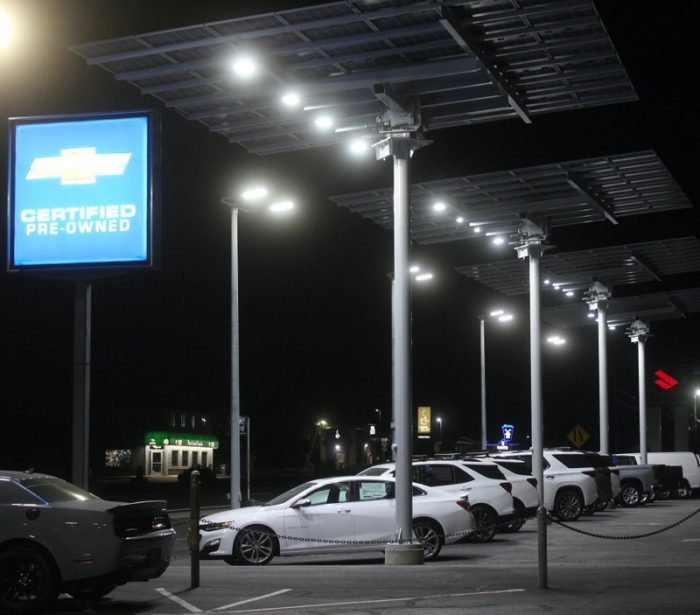
Whether you’re looking to solarize the parking lot of a small business, or are planning a city-wide project, pole-mounted solar trackers offer a solution that is versatile, cost-effective, and maintain full use of the parking lot. However, not every elevated solar tracker is created equal.
Stracker Solar’s dual-axis solar trackers are designed and manufactured here in the U.S., use all-American steel, rated for 120 mph wind and 50 psf snow loads, offer a 30-year structural warranty, and carry the highly valued UL 3703 listing, which proves compliance with the highest electrical and mechanical engineering standards. These features combined make the state-of-the-art Strackers a premium solar solution for parking lot solar projects and beyond.
With maximum solar energy production and a smallest mounting footprint, Strackers are compatible with a wide variety of sites: from open parking lots of businesses, parks, educational and medical institutions, apartment complexes, and municipalities, to fields, farms, and industrial operations. The minimum 14-foot clearance of Stracker solar trackers allows full use of the ground below and accommodates semi-trailers, fire engines, and even large industrial and farm equipment.
If you want to explore how Stracker Solar can help EPCs and developers win more projects and stand out from the competition with a cutting-edge solar power solution, visit the website or check out this episode of The Pitch:
— Solar Builder magazine

Leave a Reply
You must be logged in to post a comment.